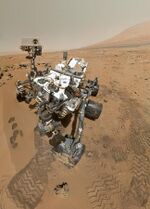Astronomy:Kepler-34b
From HandWiki
Short description: Small circumbinary gas giant orbiting the Kepler-34 star system
| Discovery | |
|---|---|
| Discovery date | 01-11-2012 |
| Transit (Kepler Mission) | |
| Orbital characteristics | |
| Epoch BJD 2454969.2000 | |
| 1.0896 ± 0.0009 AU (163,000,000 ± 130,000 km) | |
| Eccentricity | 0.182 +0.0016−0.0020 |
| Orbital period | 288.822 +0.063−0.081 d |
| Inclination | 90.355 +0.026−0.018 |
| Longitude of ascending node | −1.74 +0.14−0.16 |
| 106.5 +2.5−2.0 | |
| Star | Kepler-34 |
| Physical characteristics | |
| Mean radius | 0.764 +0.0012−0.0014 |♃|J}}}}}} 8.56 R⊕ |
| Mass | 0.220 +0.011−0.010 |♃|J}}}}}} (69.9 M⊕) |
| Mean density | 0.613 +0.045−0.041 g cm−3 |
| 936 +57−54 m/s² | |
| Physics | 323 |
Kepler-34b (formally Kepler-34(AB)b) is a circumbinary planet announced with Kepler-35b. It is a small gas giant that orbits every ~288 days around two stars. Despite the planet's relatively long orbital period, its existence could be confirmed quickly due to transiting both of its host stars.
Kepler-34b was unlikely to form at its current orbit, and likely migrated early from its birth orbit beyond 1.5 AU away from its parent binary stars, suffering multiple giant impacts in the process.[1] The eccentricity of its planetary orbit might have been acquired on the last stage of migration, due to interaction with the residual debris disk,[2] or by ejection of a second planet.[3]
References
- ↑ Lines, S.; Leinhardt, Z. M.; Paardekooper, S.; Baruteau, C.; Thebault, P. (2014), "Forming Circumbinary Planets: N -Body Simulations of Kepler-34", The Astrophysical Journal 782 (1): L11, doi:10.1088/2041-8205/782/1/L11, Bibcode: 2014ApJ...782L..11L
- ↑ Pierens, A.; Nelson, R. P. (2013), "Migration and gas accretion scenarios for the Kepler 16, 34, and 35 circumbinary planets", Astronomy & Astrophysics 556: A134, doi:10.1051/0004-6361/201321777, Bibcode: 2013A&A...556A.134P
- ↑ Gong, Yan-Xiang; Ji, Jianghui (2017), "The Scattering Outcomes of Kepler Circumbinary Planets: Planet Mass Ratio", The Astronomical Journal 154 (5): 179, doi:10.3847/1538-3881/aa8c7c, Bibcode: 2017AJ....154..179G
 |



